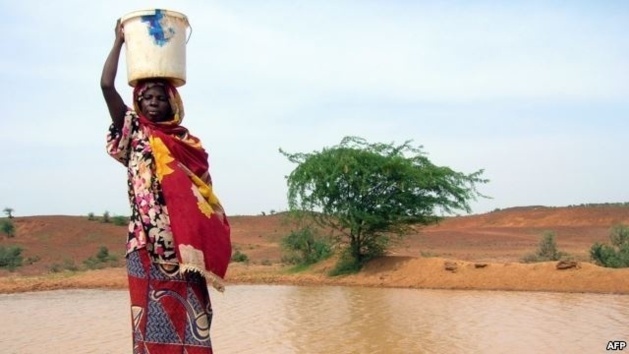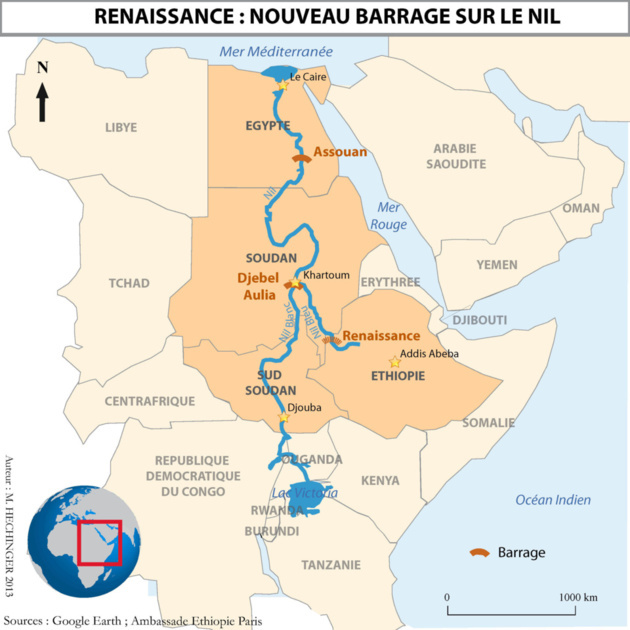
The construction by Ethiopia of a huge dam on the Blue Nile is threatening the water resources of Egypt, which Herodotus described as "the Nile's gift". The "Renaissance" Dam's construction, which began in April 2011, is ongoing, and is expected to be completed in 2017.
Former Egyptian President Mohamed Morsi strongly opposed the construction and stepped up threats against Ethiopian authorities. In his last statement of that kind, which was issued on 10 June 2013, he warned Ethiopia that Egypt will not tolerate anything that could "diminish the Nile by one drop". This construction creates great concern, given that almost 90% of the water supply of 84 million Egyptians depends on the Nile River.
Former Egyptian President Mohamed Morsi strongly opposed the construction and stepped up threats against Ethiopian authorities. In his last statement of that kind, which was issued on 10 June 2013, he warned Ethiopia that Egypt will not tolerate anything that could "diminish the Nile by one drop". This construction creates great concern, given that almost 90% of the water supply of 84 million Egyptians depends on the Nile River.
Egypt vs. Ethiopia: will there be a water war?
The rise in tensions takes place in a region that has been enduring increasing water stress and has been experiencing significant political changes since the Muslim Brothers' rise to power in Egypt [and even more since the recent fall of the government, Editor’s note]. Mohamed Morsi and his compatriots were more aggressive on this topic than his predecessor Hosni Mubarak.
The « Renaissance » project offends the rights acquired by Egypt during the colonial period. An agreement was reached in 1929 (it was then amended in 1959) between the Anglo-Egyptian administration and Sudan, in order to make an equitable sharing of the flow of the Nile River. Egypt (with 55.5 billion cubic meters) and Sudan (with 18.5 billion cubic meters) got the lion's share, i.e. 87% of the river's flow. Icing on the cake: Egypt had up till now a right of veto on all facilities built upstream. However, several of the 11 states crossed by the Nile River now want to have a say on the "blue gold" sharing. After about 10 years of negotiations, Ethiopia, Uganda, Tanzania and Rwanda reached an agreement in Entebbe (Uganda) on 14 May 2010. The treaty came into force in 2011, when Kenya and Burundi joined the agreement. Concerned with the protection of their national interests, Sudan and Egypt boycotted the agreement, whose goal is to put an end both to Egypt's control over the Nile water resources and to its right of veto which is seen as illegitimate.
Even though he affirmed that Egypt did not want war, former President Mohamed Morsi remained silent while Egyptian officials, who were secretly filmed, proposed to launch aerial bombings or to support Ethiopian rebels. Therefore, M. Morsi did not officially rule out these possibilities. In the 1970s, Egyptian President Anouar Al-Sadate threatened to bomb Ethiopia in response to Ethiopia's construction project of a dam.
The « Renaissance » project offends the rights acquired by Egypt during the colonial period. An agreement was reached in 1929 (it was then amended in 1959) between the Anglo-Egyptian administration and Sudan, in order to make an equitable sharing of the flow of the Nile River. Egypt (with 55.5 billion cubic meters) and Sudan (with 18.5 billion cubic meters) got the lion's share, i.e. 87% of the river's flow. Icing on the cake: Egypt had up till now a right of veto on all facilities built upstream. However, several of the 11 states crossed by the Nile River now want to have a say on the "blue gold" sharing. After about 10 years of negotiations, Ethiopia, Uganda, Tanzania and Rwanda reached an agreement in Entebbe (Uganda) on 14 May 2010. The treaty came into force in 2011, when Kenya and Burundi joined the agreement. Concerned with the protection of their national interests, Sudan and Egypt boycotted the agreement, whose goal is to put an end both to Egypt's control over the Nile water resources and to its right of veto which is seen as illegitimate.
Even though he affirmed that Egypt did not want war, former President Mohamed Morsi remained silent while Egyptian officials, who were secretly filmed, proposed to launch aerial bombings or to support Ethiopian rebels. Therefore, M. Morsi did not officially rule out these possibilities. In the 1970s, Egyptian President Anouar Al-Sadate threatened to bomb Ethiopia in response to Ethiopia's construction project of a dam.
The « Renaissance » Dam: Africa's biggest hydroelectric power plant

The Renaissance Dam should become Africa's biggest hydroelectric power plant and the second biggest hydroelectric power plant in the world, after the Three Gorges Dam in China.
According to Didier Grébert, Director of the French Development Agency (AFD), Ethiopia, with a population of 90 million people, hopes to become a "continental power" in the field of electricity production. Ethiopia, also nicknamed "the water-tower of Africa" has so far taken little advantage of its strategic position upstream the Nile River. While both Egypt and Sudan have respectively already built the famous Aswan Dam and the Jebel Aulia Dam, it is estimated that the construction of the Renaissance Dam should reduce the river flow downstream by 10 to 20%. However, Dina Mufti, spokesman of the Ethiopian Ministry of Foreign Affairs, said on the French radio RFI that his country has always looked at a "win-win investment".
The Ethiopian hydroelectric power plant will produce up to 6,000 megawatts of electricity and its capacity should be increased up to 10,000 megawatts by 2018. Beyond the satisfaction of its domestic energy requirements, Ethiopia is also planning to export electricity to other African countries, which would be conducive to regional development. Half of the African population does not have regular access to electricity.
According to Didier Grébert, Director of the French Development Agency (AFD), Ethiopia, with a population of 90 million people, hopes to become a "continental power" in the field of electricity production. Ethiopia, also nicknamed "the water-tower of Africa" has so far taken little advantage of its strategic position upstream the Nile River. While both Egypt and Sudan have respectively already built the famous Aswan Dam and the Jebel Aulia Dam, it is estimated that the construction of the Renaissance Dam should reduce the river flow downstream by 10 to 20%. However, Dina Mufti, spokesman of the Ethiopian Ministry of Foreign Affairs, said on the French radio RFI that his country has always looked at a "win-win investment".
The Ethiopian hydroelectric power plant will produce up to 6,000 megawatts of electricity and its capacity should be increased up to 10,000 megawatts by 2018. Beyond the satisfaction of its domestic energy requirements, Ethiopia is also planning to export electricity to other African countries, which would be conducive to regional development. Half of the African population does not have regular access to electricity.
Ethiopia moves forward with green energy
Since 2004, Ethiopia has experienced an exceptional development, with growth rate of more than 10% until 2010. Therefore, the government seeks to favor this development by increasing energy provision for the population. Ethiopia lost the international community’s support because of the lack of environmental consideration; since then, the country has been self-financing this gigantic project via "diaspora bonds" (equivalent to Treasury bonds) bought by Ethiopians themselves.
In spite of Egypt's opposition, the Ethiopian authorities still carry on the construction of the dam. However, this is not the only construction of this scale in Ethiopia. With 87 wind turbines located on the Tigray Plateau, Ethiopia is home to the largest wind farm in Africa. According to Romain Pélissier, Director of the Ashegoda Wind Farm, there is an ideal balance for green energy in the region: hydroelectricity is privileged during the rainy season, and the dry season's strong wind makes the wind farm profitable.
Green energy is more and more considered as a solution for Africa's development. Morocco has already begun to use solar energy and is planning to export it to European countries by 2015. African countries could therefore become energy powers, as long as they do not destroy each other in defending their domestic interests.
In spite of Egypt's opposition, the Ethiopian authorities still carry on the construction of the dam. However, this is not the only construction of this scale in Ethiopia. With 87 wind turbines located on the Tigray Plateau, Ethiopia is home to the largest wind farm in Africa. According to Romain Pélissier, Director of the Ashegoda Wind Farm, there is an ideal balance for green energy in the region: hydroelectricity is privileged during the rainy season, and the dry season's strong wind makes the wind farm profitable.
Green energy is more and more considered as a solution for Africa's development. Morocco has already begun to use solar energy and is planning to export it to European countries by 2015. African countries could therefore become energy powers, as long as they do not destroy each other in defending their domestic interests.



























